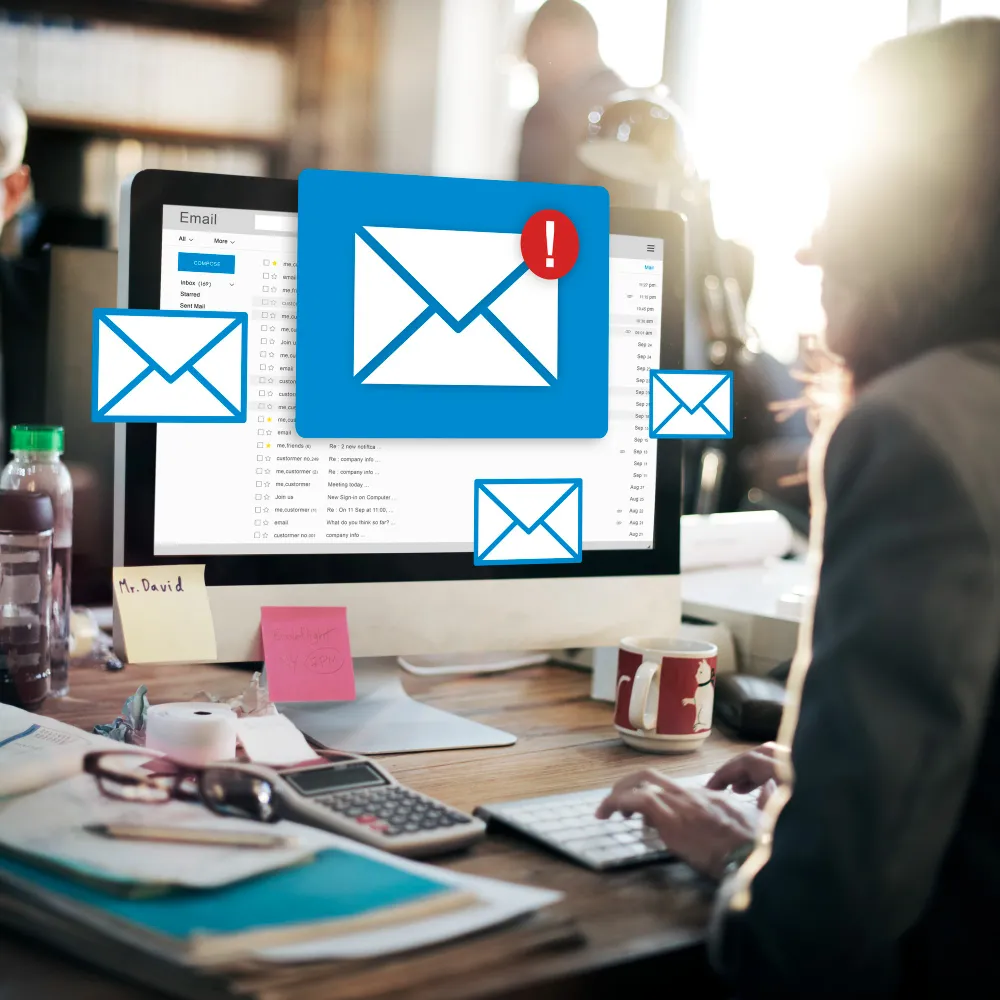Picture this: You wake up to find an email waiting in your inbox. As you scroll through the subject line, your curiosity is piqued. Opening the email, you discover a personalized message that speaks directly to your interests and needs. It feels as if the sender truly understands you. This is the power of personalization in email marketing.
In this blog post, we will explore how personalization can revolutionize your email campaigns. From understanding the importance of personalization to creating targeted content and optimizing your strategies, we will equip you with the knowledge and tools to create impactful email campaigns that resonate with your audience.
The Power of Personalization
Personalization in email marketing refers to tailoring your email content to individual recipients based on their preferences, behaviors, and demographics. It goes beyond simply addressing them by their name—it’s about crafting relevant, customized experiences that make your subscribers feel valued and understood.


Why invest in personalization? The answer lies in its effectiveness. Personalized emails have higher open rates, click-through rates, and conversion rates compared to generic emails. By delivering content that resonates with your audience, you can foster stronger connections, increase engagement, and drive meaningful actions.
Statistics reveal the impact of personalization in email marketing. According to a study by Campaign Monitor, emails with personalized subject lines are 26% more likely to be opened. Furthermore, Experian found that personalized emails generate six times higher transaction rates. These figures highlight the power of personalization in capturing your audience’s attention and driving desirable outcomes.
Think of personalization as storytelling. By gathering insights about your subscribers, you can craft narratives that speak directly to their interests, challenges, and aspirations. Whether it’s recommending relevant products or sharing tailored content, personalization allows you to engage your audience on a deeper level and build lasting connections.
The Journey to Personalization: Understanding Your Audience
Understanding the Importance: To create personalized email campaigns that resonate with your audience, you must first have a deep understanding of who they are. By gathering and analyzing customer data, you can gain valuable insights into their preferences, behaviors, and needs. This knowledge forms the foundation for effective personalization.


Customer Data Collection
Start by collecting relevant customer data through various channels such as website analytics, social media interactions, and customer surveys. This data can include demographics, purchase history, browsing behavior, and preferences. Use online tools and analytics platforms to gather and organize this information.
Customer Segmentation
Segment your audience based on shared characteristics or behaviors. This allows you to create targeted email campaigns that address specific segments’ needs and interests. Consider factors like age, gender, location, purchasing behavior, or engagement level. The more specific your segments, the more tailored your content can be.
Creating Personalized Content
Once you have a deep understanding of your audience, it’s time to create personalized email content that resonates with each segment. Personalization goes beyond using recipients’ names; it involves tailoring the message, tone, and imagery to match their unique preferences and needs. Here’s a step-by-step guide to creating personalized email content:


Tailor Your Message
Use the data you’ve collected to personalize your email content. Address recipients by their names, and craft subject lines that grab their attention. Tailor the email body to align with their interests, preferences, and purchase history. Incorporate dynamic content such as product recommendations based on past purchases or personalized offers.
Personalization Tokens
Most email marketing platforms offer personalization tokens that dynamically insert recipient-specific information into the email. Utilize these tokens to create a sense of individualization. For example, include their recent purchase history or upcoming events in their area.
Storytelling and Relevance
Connect with your audience through compelling storytelling. Create narratives that resonate with their experiences and aspirations. Use relatable language and references to build an emotional connection. Make your content relevant to their current stage in the customer journey or any recent interactions they’ve had with your brand.
Visual Appeal
Enhance the visual appeal of your emails with personalized images or product recommendations. Visual elements tailored to each recipient can capture their attention and drive engagement. Showcase images of products they’ve shown interest in or include images related to their preferences.
By focusing on understanding your audience and creating personalized content, you can deliver emails that feel unique and relevant to each recipient
Segmenting Your Email List
Email segmentation involves dividing your subscriber list into smaller, more targeted groups based on specific characteristics or behaviors. By segmenting your list, you can deliver highly relevant content to each group, increasing the effectiveness of your email campaigns.
Here are some effective strategies for segmenting your email list:


Demographic Segmentation
Divide your subscribers based on age, gender, location, or other relevant demographic factors. This allows you to tailor content specifically to each group’s preferences and needs.
Behavioral Segmentation
Segment your list based on the actions subscribers have taken, such as purchases, website visits, or email interactions. Send targeted emails based on their behaviors to encourage further engagement and conversions.
Lifecycle Stage Segmentation
Categorize subscribers based on their stage in the customer journey, such as new leads, active customers, or loyal advocates. Customize your email content to nurture leads, retain customers, or reward loyal supporters.
Interest-Based Segmentation
Identify subscribers’ interests and preferences through surveys, preference centers, or past interactions. Group them based on their stated interests or content engagement, and deliver personalized emails that cater to their specific interests.
Suppose you operate an e-commerce store selling sports equipment. By segmenting your email list, you can create targeted campaigns for different sports enthusiasts, such as basketball, soccer, or tennis. Each segment would receive emails featuring products, tips, and promotions relevant to their specific interests, maximizing the chances of engagement and conversions.
Testing and Optimizing Your Personalized Emails
To ensure the effectiveness of your personalized email campaigns, testing and optimization are key. By experimenting with different elements and analyzing the results, you can refine your strategies and maximize engagement and conversions. Here’s how to test and optimize your personalized emails:


A/B Testing
Create variations of your emails with different personalized elements, such as subject lines, content, or call-to-action buttons. Split your subscriber list into two segments and send each segment a different version. Analyze the performance metrics, such as open rates, click-through rates, and conversions, to identify which version resonates better with your audience.
Test Different Personalization Variables
Experiment with different personalization tokens, such as name, location, or past purchases, to see which ones generate the most engagement. For example, test whether using the recipient’s first name in the subject line increases open rates compared to using their last name.
Measure Key Performance Indicators (KPIs)
Identify the KPIs that align with your campaign goals, such as open rates, click-through rates, conversion rates, or revenue generated. Continuously monitor these metrics to gauge the effectiveness of your personalized emails and identify areas for improvement.
Optimize Based on Insights
Analyze the data from your A/B tests and performance metrics to uncover patterns and insights. Make data-driven decisions to optimize your future email campaigns. Iterate on your strategies, adjusting the content, personalization variables, and segmentation based on the insights gained.
Suppose you’re an online fashion retailer and want to test the impact of personalized product recommendations in your emails. You create two versions of the same email—one with personalized recommendations based on the recipient’s browsing history and purchase behavior, and the other with generic recommendations. By comparing the metrics of both versions, such as click-through rates and conversions, you can determine whether personalized recommendations drive higher engagement and sales.
The Do’s and Don’ts of Email Personalization
To ensure successful email personalization, follow these best practices:


Do Collect and Utilize Relevant Data
Gather accurate and up-to-date data about your subscribers’ preferences, behavior, and demographics. Use this data to personalize your emails effectively.
Do Segment Your Email List
Divide your subscriber base into meaningful segments based on relevant criteria, such as demographics, behavior, or interests. This enables you to deliver targeted content that resonates with each group.
Do Use Dynamic Content
Incorporate dynamic content blocks that adapt based on each recipient’s data. This allows you to deliver personalized recommendations, offers, or greetings that are relevant to the individual.
Don’t Overpersonalize
While personalization is crucial, avoid overusing personal information or making assumptions that may come across as intrusive. Strike a balance between personalization and respecting subscribers’ privacy.
Don’t Neglect Testing
Test different elements, variables, and strategies to optimize your personalized email campaigns. Regularly analyze the results and make data-driven decisions to enhance performance.
Be aware of these common mistakes and avoid them in your email personalization efforts:
Failing to Verify Data Accuracy
Ensure that the data you collect is accurate and reliable. Outdated or incorrect data can lead to ineffective personalization and alienate your subscribers.
Ignoring Customer Preferences
Pay attention to your subscribers’ preferences and consent. Respect their communication preferences and allow them to easily opt out or update their preferences.
Being Inconsistent with Brand Voice
Maintain a consistent brand voice across your personalized emails. Inconsistency can confuse or dilute your brand identity, leading to a lack of trust and engagement.
Overcomplicating Personalization
Keep your personalization efforts simple and focused. Overcomplicating the process may lead to errors, confusion, or overwhelming the recipient with too much information.
Conclusion
In today’s digital landscape, email personalization has emerged as a powerful tool for marketers to connect with their audience on a deeper level. By creating targeted and personalized email campaigns, businesses can engage recipients, drive conversions, and foster long-term customer relationships.
By mastering the art of email personalization, you can create targeted and impactful campaigns that not only drive immediate results but also nurture strong and loyal customer relationships over time. Remember, in the digital age, personalization is the key to standing out and building meaningful connections with your audience. Harness its power and unlock the true potential of your email marketing efforts.
Ready to take your email marketing to the next level? Contact Neuroimpakt today to discover how our expertise in personalized email campaigns can help your business achieve its goals.


